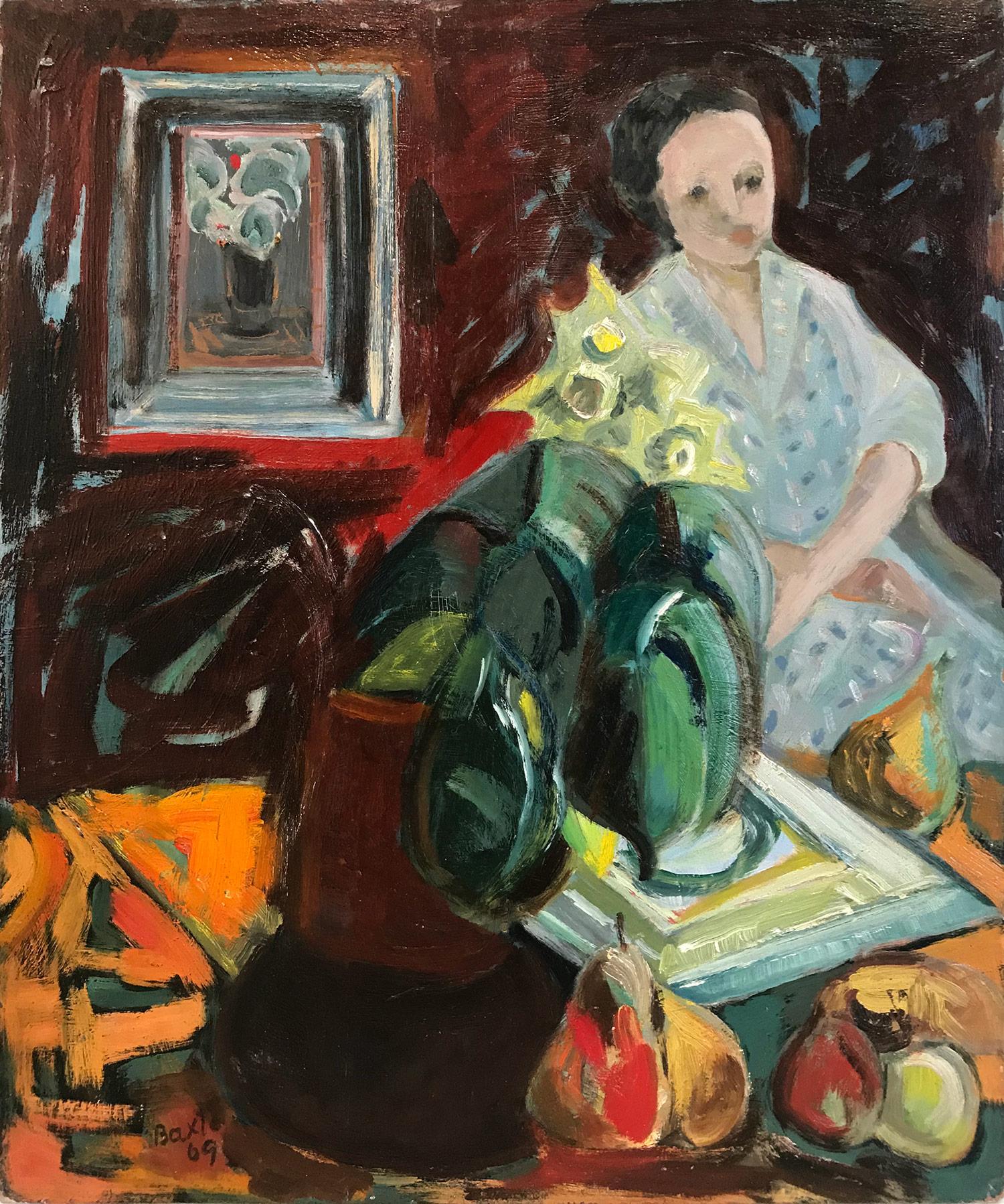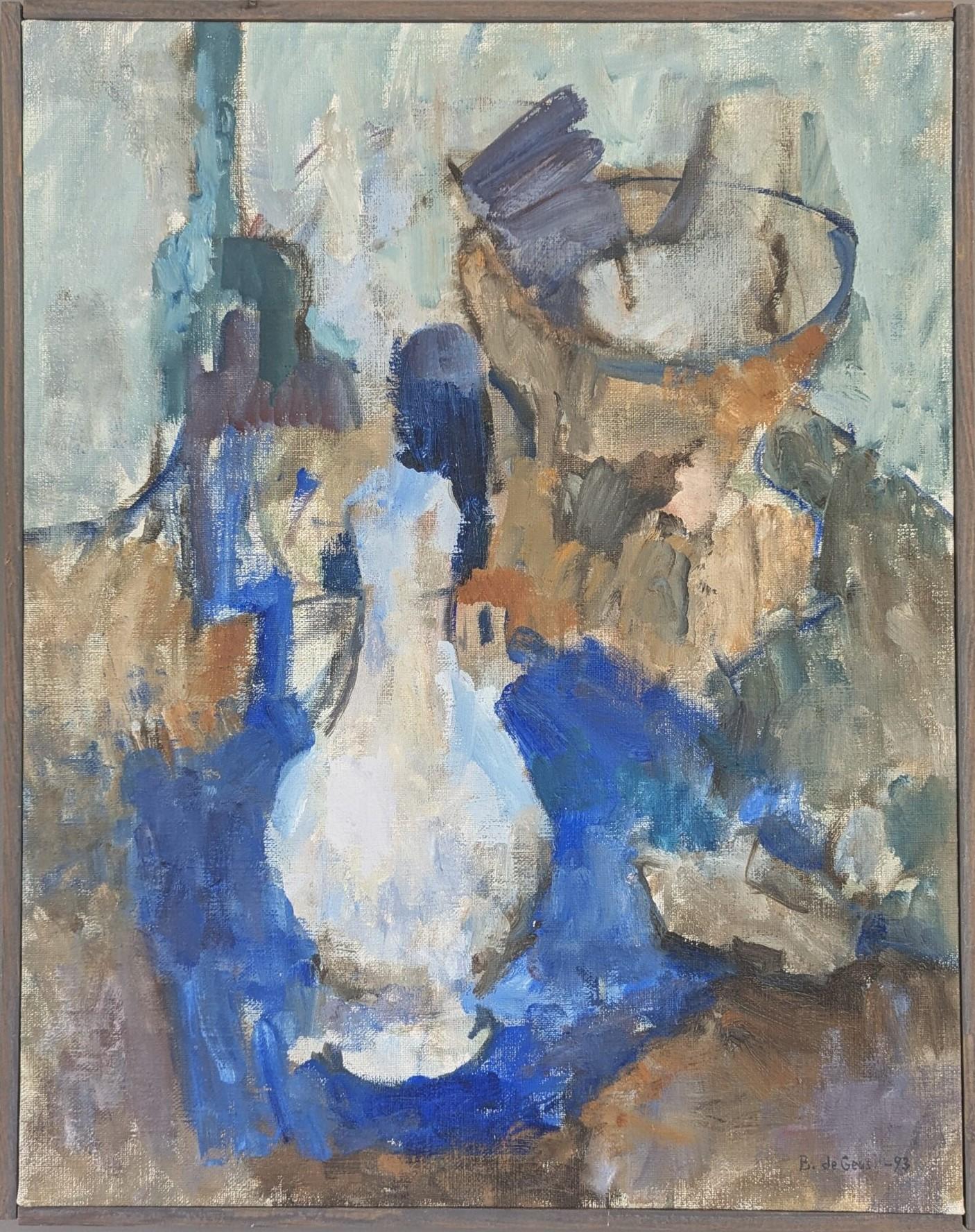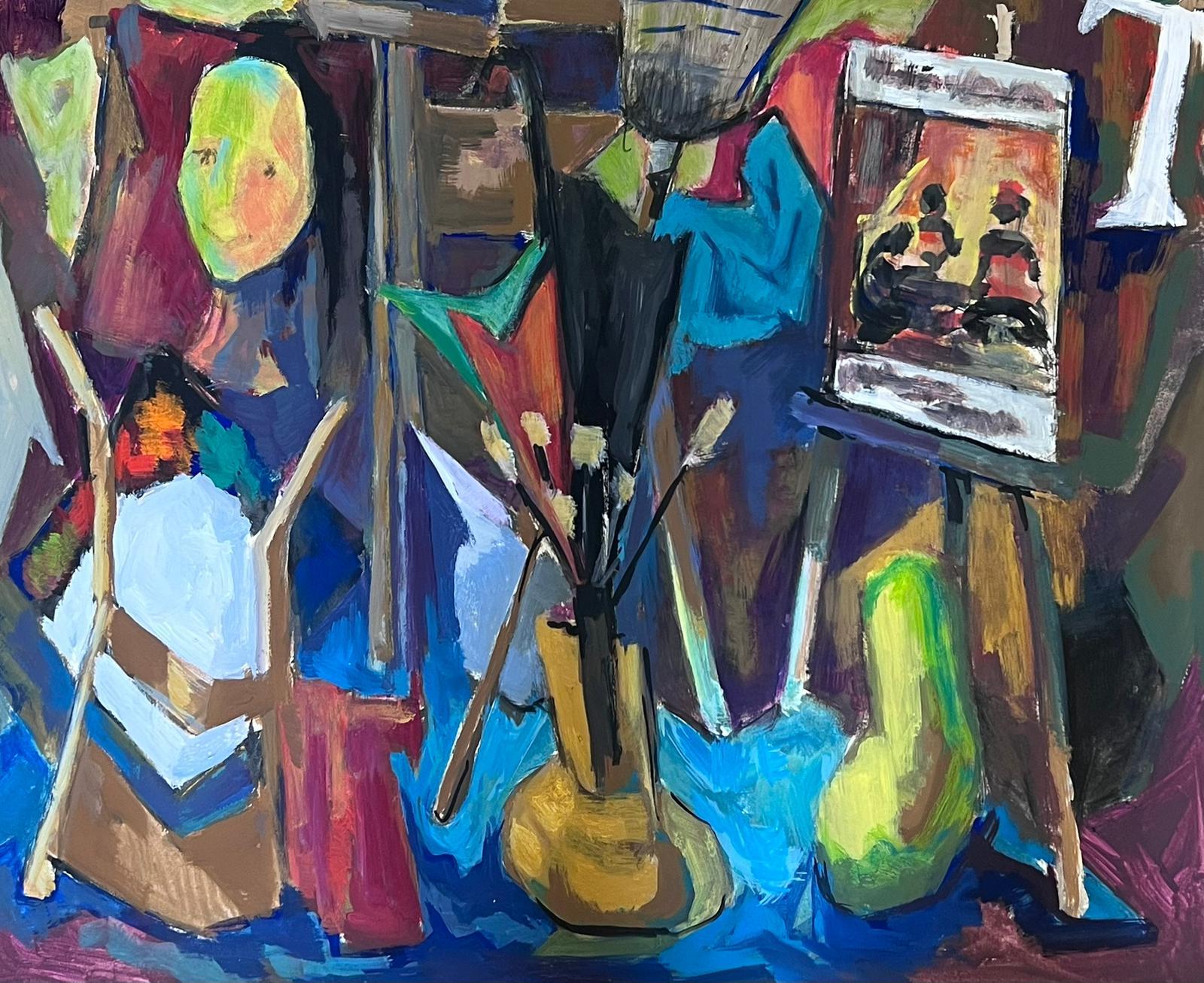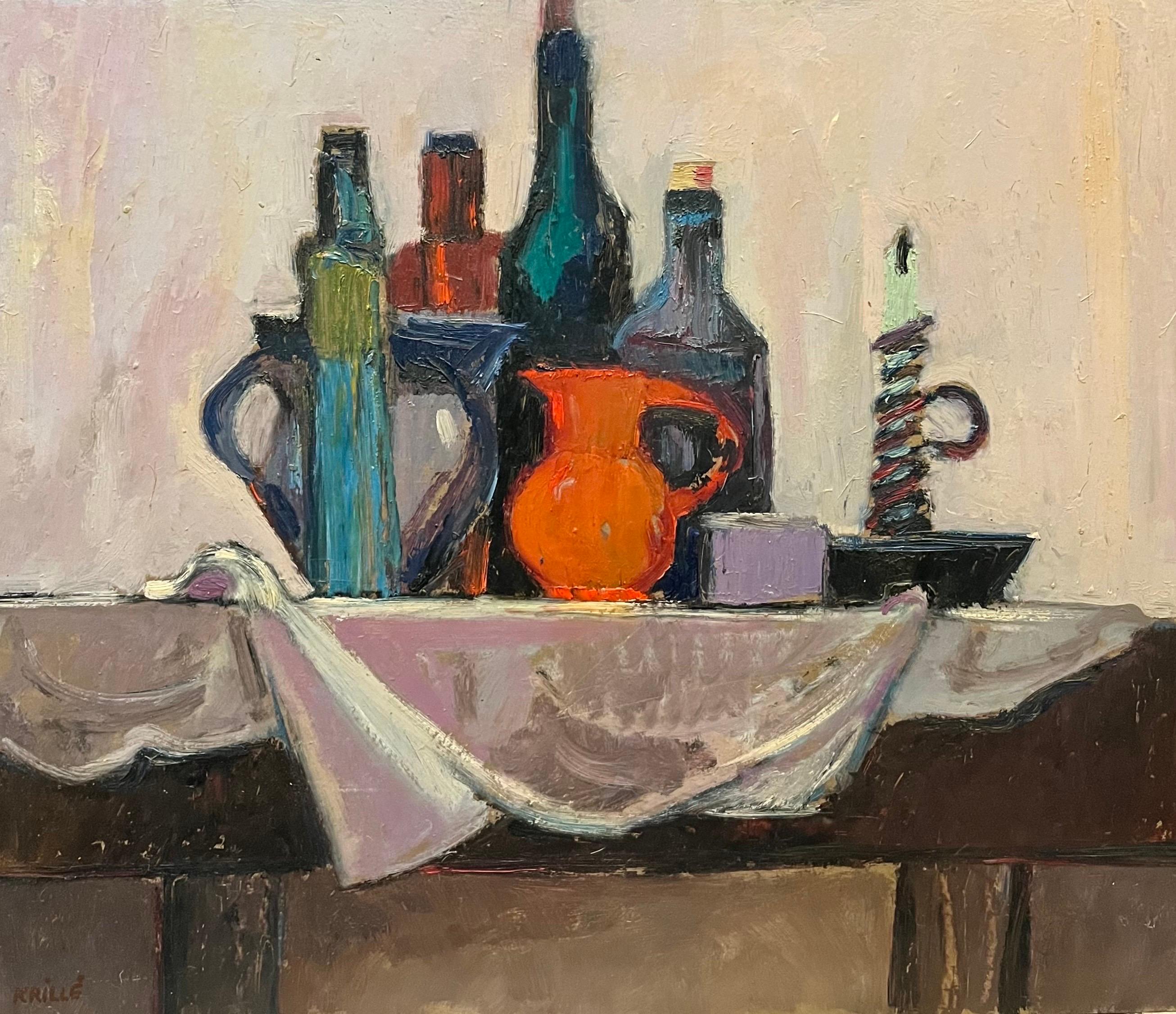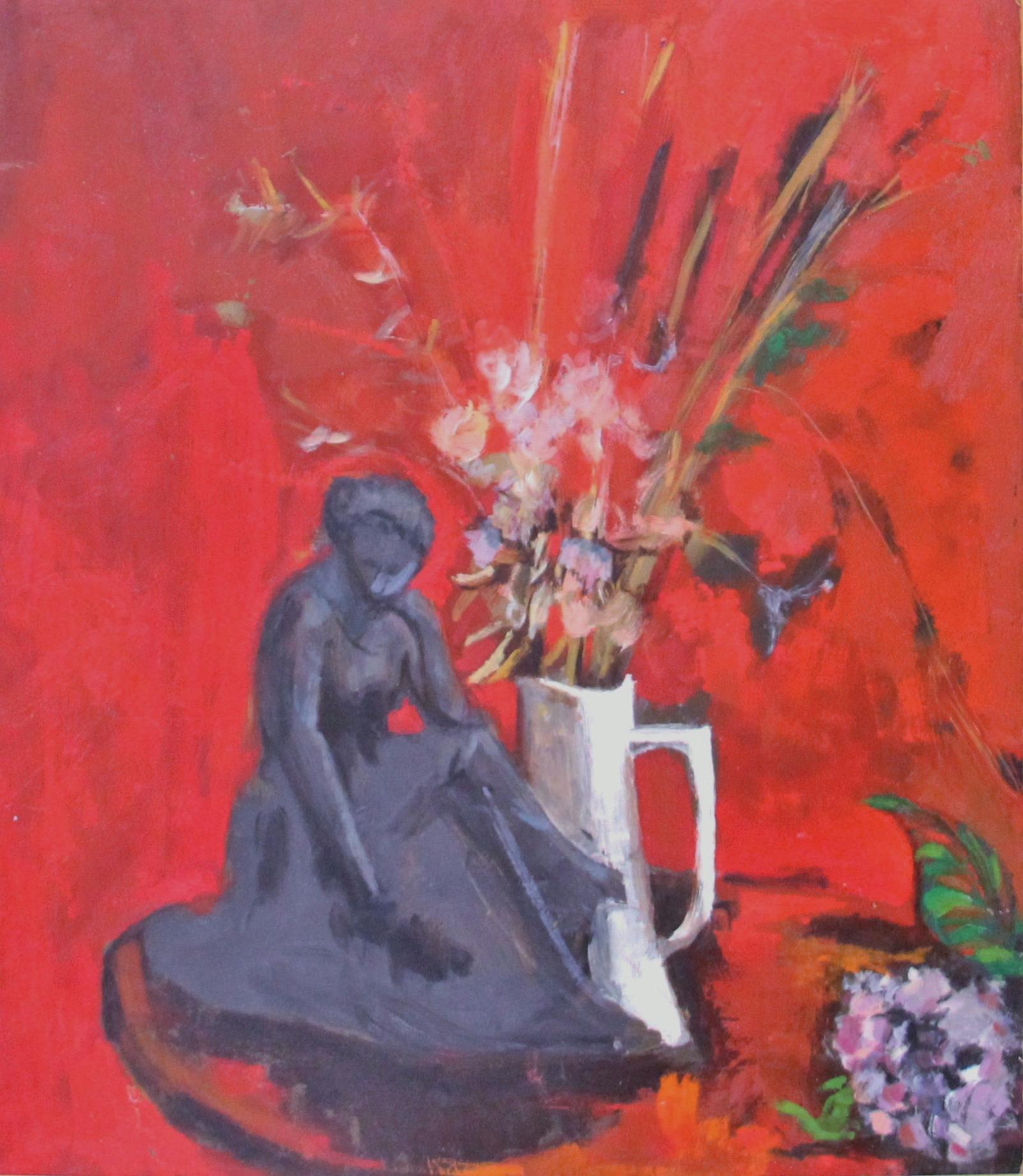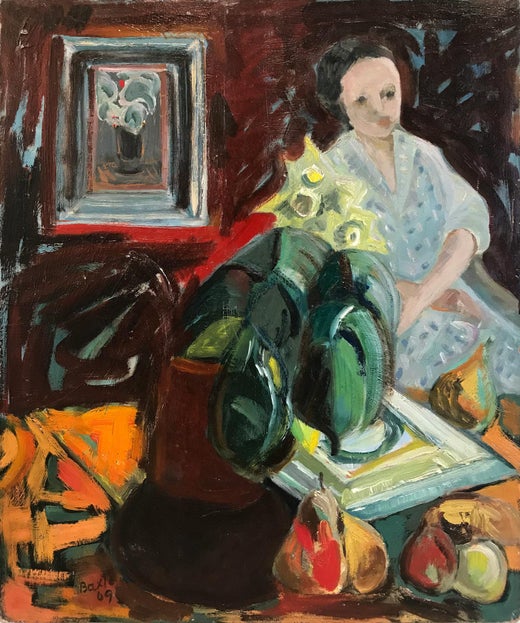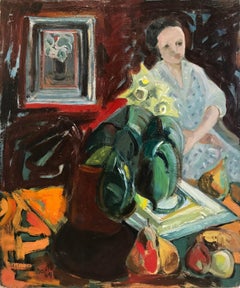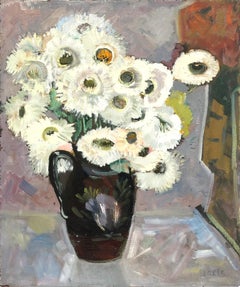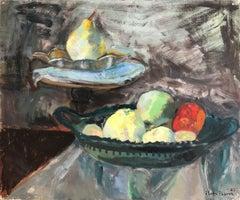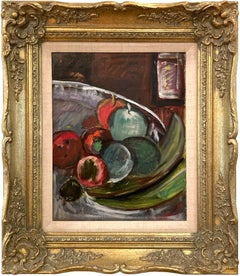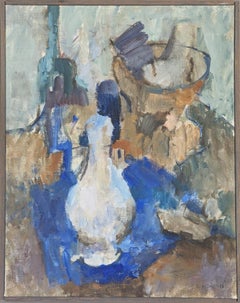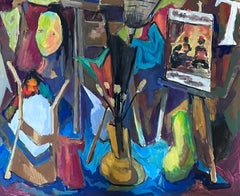Items Similar to "Artist Painting Still Life" Expressionistic Style Oil Painting on Canvas
Want more images or videos?
Request additional images or videos from the seller
1 of 15
Michael Baxte"Artist Painting Still Life" Expressionistic Style Oil Painting on CanvasMid-20th Century
Mid-20th Century
$2,800
£2,121.53
€2,434.29
CA$3,940.05
A$4,331.20
CHF 2,276.28
MX$52,596.56
NOK 28,396.03
SEK 26,903.24
DKK 18,167.71
About the Item
A strong modernist oil painting depicted in the Mid Centruy by Russian painter Michael Baxte. Mostly known for his abstracted figures on canvas or street scenes, this piece is a wonderful representation of his interior scenes with expressive use of color, shape, and form. Later in his career, Baxte explores Expressionism, infusing both European and North American stylistic trends.
This painting measures 32 x 25.5 inches
Michael Posner Baxte was born in 1890 in the small town of Staroselje Belarus, Russia. For the first half of the 19th century, it was a center of the Chabad movement of Hasidic Jews, but this group was gone by the middle of the 19th century. By the time the Baxte family immigrated to the United States at the beginning of the 20th century, the Jewish population numbered only on the hundreds. The native language of the Baxte family was Yiddish. It is likely that the death of Michael Baxte’s father triggered the family’s immigration. Three older brothers arrived in New York between 1903 and 1905. Michael and his mother, Rebecca, arrived in 1907. By 1910 Michael, his mother, and brother, Joseph, were living in New Orleans and may have spent some time on a Louisiana plantation. Around 1912, Michael Baxte returned to Europe to study the violin. In 1914 he, his mother, and Joseph moved to New York City.
Meanwhile, in Algeria, a talented young woman painter, Violette Mege, was making history. For the first time, a woman won the prestigious Beaux Art competition in Algeria. At first, the awards committee denied her the prize but, with French government intervention, Mege eventually prevailed. She won again 3 years later and, in 1916, used the scholarship to visit the United States of America. When Violette came to New York, she met Baxte, who was, by then, an accomplished violinist, teacher, and composer. Baxte’s compositions were performed at the Tokyo Imperial Theater, and in 1922 he was listed in the American Jewish Yearbook as one of the prominent members of the American Jewish community. As a music teacher, he encouraged individual expression. Baxte stated, “No pupil should ever be forced into the imitation of the teacher. Art is a personal experience, and the teacher’s truest aim must be to awaken this light of personality through the patient's light of science.”
By 1920 Michael Baxte and Violette Mege were living together in Manhattan. Although they claimed to be living as husband and wife, it seems that their marriage did not become official until 1928. On their “unofficial” honeymoon around 1917, in Algiers, Baxte confided to her his ambition to paint. There and later in New Mexico where the wonderful steeped sunlight approximates the coloring of Algiers, she taught him his heart’s desire. He never had any other teacher. She never had any other pupil. For ten years she devoted all her time, energy, and ambition to teaching, encouraging, inspiring him. Then in 1928, their mutual strivings were rewarded, as his works were being chosen as one of the two winners in the Dudensing National Competition for American Painters. Out of 150 artists from across the country participated in the Dudensing, and Michael Posner Baxte and, Robert Fawcett, were the winners.
In his 1924 naturalization application, he indicated that he was sometimes known as “Michael Posner Baxte.” One of the witnesses to his application was Bernard Karfiol, a Jewish American artist. That’s when Michael may have decided to use the name Baxte for his art. Baxte, née Posner, received critical acclaim from art critics. In 1929, Lloyd Goodrich of The New York Times wrote, “Mr. Baxte has a way of choosing aspects of the world that are quite unhackneyed… He is an artist of considerable subtlety, not too strong perhaps, and sometimes a little uncertain, but always sensitive and interesting. One feels in each of his pictures an absorption in his subject and an individual manner of looking at it. He has a very attractive color sense, warm, sensuous, and unexpected, which seems natural and unforced.” A dozen years later another New York Times art critic, Howard Devree, commented, “Also at the Bonestell are paintings by Michael Baxte, who lays in his color with gusto and considerable acumen.”
During the 1930’s Baxte and his wife, Violet, lived in France and spent most of their time in Paris, where Baxte became part of the School of Paris and exhibited his artwork in government-sponsored exhibitions including the Salon d'Automne, helping as well to organize an exhibition of American painters. When World War II began, and Paris became unsafe Baxte and his wife relocated to Mexico where they continued to live and work. Baxte died in 1972 in Mexico.
PROVENANCE: Private collection; Lilac Gallery Collection. The piece will be stamped from Lilac Gallery on its verso.
- Creator:Michael Baxte (1890 - 1972, Russian)
- Creation Year:Mid-20th Century
- Dimensions:Height: 32 in (81.28 cm)Width: 25.5 in (64.77 cm)Depth: 1 in (2.54 cm)
- Medium:
- Movement & Style:
- Period:
- Framing:Framing Options Available
- Condition:This piece is in excellent condition besides some wear on outer edge of the canvas from age.
- Gallery Location:New York, NY
- Reference Number:Seller: 0032971stDibs: LU9827057732
Michael Baxte
Michael Baxte was an American painter. His work was part of the painting event in the art competition at the 1936 Summer Olympics. During the 1930s Baxte and his wife, Violet, lived in France and spent most of their time in Paris, where Baxte became part of the School of Paris and exhibited his artwork in government-sponsored exhibitions, including the Salon d'Automne, helping as well to organize an exhibition of American painters. When World War II began, and Paris became unsafe, Baxte and his wife relocated to Mexico, where they continued to live and work. Baxte died in 1972 in Mexico.
About the Seller
5.0
Platinum Seller
Premium sellers with a 4.7+ rating and 24-hour response times
Established in 2012
1stDibs seller since 2015
1,792 sales on 1stDibs
Typical response time: 1 hour
- ShippingRetrieving quote...Shipping from: New York, NY
- Return Policy
Authenticity Guarantee
In the unlikely event there’s an issue with an item’s authenticity, contact us within 1 year for a full refund. DetailsMoney-Back Guarantee
If your item is not as described, is damaged in transit, or does not arrive, contact us within 7 days for a full refund. Details24-Hour Cancellation
You have a 24-hour grace period in which to reconsider your purchase, with no questions asked.Vetted Professional Sellers
Our world-class sellers must adhere to strict standards for service and quality, maintaining the integrity of our listings.Price-Match Guarantee
If you find that a seller listed the same item for a lower price elsewhere, we’ll match it.Trusted Global Delivery
Our best-in-class carrier network provides specialized shipping options worldwide, including custom delivery.More From This Seller
View All"Interior Scene with Figure" Expressionistic Style Oil Painting on Masonite
By Michael Baxte
Located in New York, NY
A strong modernist oil painting depicted in 1969 by Russian painter Michael Baxte. Mostly known for his abstracted figures on canvas or street scenes, this piece is a wonderful representation of his bold still life paintings, with expressive use of color, shape, and form. Later in his career, Baxte explores Expressionism, infusing both European and North American stylistic trends. This piece is from later in his career, but we can feel this underlying style throughout.
Art measures 21.75 x 18 inches
Michael Posner Baxte was born in 1890 in the small town of Staroselje Belarus, Russia. For the first half of the 19th century it was a center of the Chabad movement of Hasidic Jews, but this group was gone by the middle of the 19th century. By the time the Baxte family immigrated to the United States at the beginning of the 20th century, the Jewish population numbered only on the hundreds. The native language of the Baxte family was Yiddish. It is likely that the death of Michael Baxte’s father triggered the family’s immigration. Three older brothers arrived in New York between 1903 and 1905. Michael and his mother, Rebecca, arrived in 1907. By 1910 Michael, his mother, and brother, Joseph, were living in New Orleans and may have spent some time on a Louisiana plantation. Around 1912, Michael Baxte returned to Europe to study the violin. In 1914 he, his mother, and Joseph moved to New York City.
Meanwhile, in Algeria, a talented young woman painter, Violette Mege, was making history. Since for the first time, a woman won the prestigious Beaux Art competition in Algeria. At first, the awards committee denied her the prize but, with French government intervention, Mege eventually prevailed. She won again 3 years later and, in 1916, used the scholarship to visit the United States of America. When Violette came to New York, she met Baxte, who was, by then, an accomplished violinist, teacher, and composer. Baxte’s compositions were performed at the Tokyo Imperial Theater, and in 1922 he was listed in the American Jewish Yearbook as one of the prominent members of the American Jewish community. As a music teacher he encouraged individual expression. Baxte stated, “No pupil should ever be forced into imitation of the teacher. Art is a personal experience, and the teacher’s truest aim must be to awaken this light of personality through the patient light of science.”
By 1920 Michael Baxte and Violette Mege were living together in Manhattan. Although they claimed to be living as husband and wife, it seems that their marriage did not become official until 1928. On their “unofficial” honeymoon around 1917, in Algiers, Baxte confided to her his ambition to paint. There and later in New Mexico where the wonderful steeped sunlight approximates the coloring of Algiers, she taught him his heart’s desire. He never had any other teacher. She never had any other pupil. For ten years she devoted all her time, energy, and ambition to teaching, encouraging, inspiring him. Then in 1928, their mutual strivings were rewarded, as his works were being chosen as one of the two winners in the Dudensing National Competition for American Painters. Out of 150 artists from across the country participated in the Dudensing, and Michael Posner Baxte and, Robert Fawcett...
Category
1960s Expressionist Interior Paintings
Materials
Oil, Masonite
"Still Life with Flower Pot" Expressionistic Style Oil Painting on Masonite
By Michael Baxte
Located in New York, NY
A strong modernist oil painting depicted in Circa 1960 by Russian painter Michael Baxte. Mostly known for his abstracted figures on canvas or street scenes, this piece is a wonderful representation of his bold still life paintings, with expressive use of color, shape, and form. Later in his career, Baxte explores Expressionism, infusing both European and North American stylistic trends. This piece is from later in his career, but we can feel this underlying style throughout.
Art measures 21.75 x 18 inches
Michael Posner Baxte was born in 1890 in the small town of Staroselje Belarus, Russia. For the first half of the 19th century it was a center of the Chabad movement of Hasidic Jews, but this group was gone by the middle of the 19th century. By the time the Baxte family immigrated to the United States at the beginning of the 20th century, the Jewish population numbered only on the hundreds. The native language of the Baxte family was Yiddish. It is likely that the death of Michael Baxte’s father triggered the family’s immigration. Three older brothers arrived in New York between 1903 and 1905. Michael and his mother, Rebecca, arrived in 1907. By 1910 Michael, his mother, and brother, Joseph, were living in New Orleans and may have spent some time on a Louisiana plantation. Around 1912, Michael Baxte returned to Europe to study the violin. In 1914 he, his mother, and Joseph moved to New York City.
Meanwhile, in Algeria, a talented young woman painter, Violette Mege, was making history. Since for the first time, a woman won the prestigious Beaux Art competition in Algeria. At first, the awards committee denied her the prize but, with French government intervention, Mege eventually prevailed. She won again 3 years later and, in 1916, used the scholarship to visit the United States of America. When Violette came to New York, she met Baxte, who was, by then, an accomplished violinist, teacher, and composer. Baxte’s compositions were performed at the Tokyo Imperial Theater, and in 1922 he was listed in the American Jewish Yearbook as one of the prominent members of the American Jewish community. As a music teacher he encouraged individual expression. Baxte stated, “No pupil should ever be forced into imitation of the teacher. Art is a personal experience, and the teacher’s truest aim must be to awaken this light of personality through the patient light of science.”
By 1920 Michael Baxte and Violette Mege were living together in Manhattan. Although they claimed to be living as husband and wife, it seems that their marriage did not become official until 1928. On their “unofficial” honeymoon around 1917, in Algiers, Baxte confided to her his ambition to paint. There and later in New Mexico where the wonderful steeped sunlight approximates the coloring of Algiers, she taught him his heart’s desire. He never had any other teacher. She never had any other pupil. For ten years she devoted all her time, energy, and ambition to teaching, encouraging, inspiring him. Then in 1928, their mutual strivings were rewarded, as his works were being chosen as one of the two winners in the Dudensing National Competition for American Painters. Out of 150 artists from across the country participated in the Dudensing, and Michael Posner Baxte and, Robert Fawcett...
Category
1960s Expressionist Still-life Paintings
Materials
Oil, Masonite
"Still Life with Fruits" Russian-American Modern Colorful Oil Painting on Board
By Ben Benn
Located in New York, NY
A strong modernist oil painting depicted in 1927 by Russian-American painter Ben Benn. With a highly recognizable modern style, fast brush stroke and expressive use of color, shape, ...
Category
1920s American Modern Still-life Paintings
Materials
Oil, Board
"Still Life with Apples" Fruit Modern Mid Century Oil Painting on Board Painting
By Michael Baxte
Located in New York, NY
A strong modernist oil painting depicted in the mid Century by Russian painter Michael Baxte. Mostly known for his abstracted figures on canvas or street scenes, this piece is a wonderful representation of his bold still life paintings, with expressive use of color, shape, and form. Later in his career, Baxte explores Expressionism, infusing both European and North American stylistic trends. This piece is from later in his career, but we can feel this underlying style throughout.
Art measures 15 x 11 inches
Frame measures 22 x 19 inches
Michael Posner Baxte was born in 1890 in the small town of Staroselje Belarus, Russia. For the first half of the 19th century, it was a center of the Chabad movement of Hasidic Jews, but this group was gone by the middle of the 19th century. By the time the Baxte family immigrated to the United States at the beginning of the 20th century, the Jewish population numbered only on the hundreds. The native language of the Baxte family was Yiddish. It is likely that the death of Michael Baxte’s father triggered the family’s immigration. Three older brothers arrived in New York between 1903 and 1905. Michael and his mother, Rebecca, arrived in 1907. By 1910 Michael, his mother, and brother, Joseph, were living in New Orleans and may have spent some time on a Louisiana plantation. Around 1912, Michael Baxte returned to Europe to study the violin. In 1914 he, his mother, and Joseph moved to New York City.
Meanwhile, in Algeria, a talented young woman painter, Violette Mege...
Category
1960s Expressionist Still-life Paintings
Materials
Oil, Board
"Still Life with Flowers, Fruits and Tea" Colorful Oil on Canvas Interior Scene
Located in New York, NY
A charming miniature still life painting, depicting fruits in a basket, along with flowers in a vase, a cup of tea, and a book. It feels ...
Category
20th Century Impressionist Still-life Paintings
Materials
Canvas, Oil
"Flower Still Life" Post-Impressionism French Oil Painting of Colorful Flowers
By Jacques Zucker
Located in New York, NY
This painting depicts a whimsical bouquet of flowers in a white vase resting on a table with a multicolored background. The piece is done in a highly impressionistic manner with uniq...
Category
Mid-20th Century Post-Impressionist Still-life Paintings
Materials
Oil, Board
You May Also Like
Still life oil on canvas painting postimpressionism
Located in Barcelona, Barcelona
Technical Sheet
- Title: Still Life
- Artist: Romualdo Fernández Barrera (1933-2022)
- Medium: Oil on canvas
- Dimensions: 27.5 x 39.4 inches
- Style: Post-Impressionism
- ...
Category
1970s Post-Impressionist Still-life Paintings
Materials
Canvas, Oil
$777 Sale Price
35% Off
1993 Vintage Modernist Original Framed Oil Painting - Expressionist Still Life
Located in Bristol, GB
ESPRESSIONIST STILL LIFE
Size: 54 x 43 cm (including frame)
Oil on canvas
A brilliantly executed 20th century expressionist still life, painted in oil onto canvas and dated ’93.
Th...
Category
Mid-20th Century Modern Still-life Paintings
Materials
Canvas, Oil
French 20th Century Modernist Painting Artists Paint Room Still Life
Located in Cirencester, Gloucestershire
Artists Room
by Guy Nicod
(French 1923 - 2021)
oil on artist paper, unframed
painting : 19.75 x 24 inches
stamped verso
provenance: artists estate, France
condition: very good and s...
Category
Mid-20th Century Modern Interior Paintings
Materials
Oil
Still life 117 by Jean Krille - Oil on masonite - 50x60cm
By Jean Krille
Located in Geneva, CH
Jean Krillé’s paintings are known for their expressive use of color and dynamic, abstract forms, blending realism with abstraction in his depictions of nature. His landscapes often f...
Category
Late 20th Century Neo-Expressionist Still-life Paintings
Materials
Oil
$1,200 Sale Price
20% Off
Expressionist Still Life by Philadelphia Artist
By Bernard Harmon
Located in Doylestown, PA
"Red Still Life" is an interior still life by Philadelphia born Expressionist painter Bernard Harmon. The 28.25" x 24.25" oil on board painting is framed in a new black wood frame.
Bernard Harmon was born in Philadelphia, Pennsylvania in 1935. Harmon was primarily a portrait painter and a well loved teacher in the Philadelphia area. A graduate of the Philadelphia Museum School and Temples Tyler School of Art, Harmon traveled extensively in Europe and South America. Beloved by many, Harmon taught in the Philadelphia School District for 32 of his 54 years of life. Beginning his career as an art teacher at West Philadelphia High School, in the early 1960s he became one of the district's artists in residence, traveling from school to school to demonstrate for students how an artist works. Returning to the classroom, Harmon joined the art department at Central High School where he taught for 14 years and became an innovator in art curriculum, developing a program offering advanced placement art classes to gifted students. In his final years Harmon became a supervisor, mentoring teachers and overseeing programs in the Philadelphia school systems District #1. During his short life Harmon taught collage preparatory art classes at the Pennsylvania Academy of the Fine Arts, summer classes at the University of the Arts, and a Saturday program for gifted children at Drexel University. Among Harmon's portraits were commissioned by Philadelphia Jazz organist Jimmy Smith and Mayor Richardson Dilworth. Bernard Harmon was active in promoting African American Artist throughout his life time. He organized many early shows such as the "Afro American...
Category
1960s Expressionist Still-life Paintings
Materials
Oil, Board
Still life oil on canvas painting postimpressionism
Located in Barcelona, Barcelona
Pilar Margenat (1939) - Still life - Oil on canvas
Oil measures 92x73 cm.
Frameless.
He was born on August 2, 1939 in Sant Quirze del Vallés (Barcelona).
He studied drawing and pai...
Category
1980s Post-Impressionist Still-life Paintings
Materials
Canvas, Oil
$598 Sale Price
37% Off
